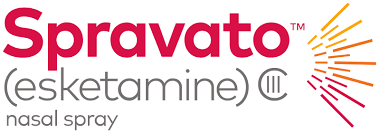Touted as potentially one of the most groundbreaking findings in psychiatry for decades, we summarize the data the FDA has collected on efficacy and side effects.
It is proposed to work by antagonizing the NMDA with facilitates glutamate release and activating AMPA. It is theorized that this enhances the signaling of neurotrophic factors and thus promotes rapid and long-term antidepressant effects. Per the FDA, there is an induction phase where this intranasal formulation is given twice a week for four weeks and then maintenance dosing is once a week or once every 2 weeks. It is self-administered but at a medical site where medical supervision is provided. The nasal formulation is rapidly absorbed with time to peak serum levels being approximately 40 minutes.
The FDA studied over 1700 patients prior to the approval. This is cumulative across multiple studies they performed. In one of the studies, 114 patients were assigned esketamine to be taken with a new antidepressant and another 109 patients were assigned placebo to be taken with the new antidepressant. Patients were blinded to which treatment arm they were in. The esketamine group found an improvement in the MADRS by 21.4 points versus 17 points in the placebo group by the 28th day of treatment. This was statistically significant. Patients 65 years of age and older were also studied.
Of particular interest though is the study on long-term maintenance. For both patients who have responded (over 50% reduction in symptoms) or experienced full remission, continued treatment with esketamine as an adjunctive treatment with an antidepressant was found superior to placebo. In brief, there does seem to be some sustainable benefit.
The FDA has also investigated to some degree, long-term safety. 479 patients were exposed for at least 6 months and 178 patients were exposed for at least 12 months. The most common side effects were nausea, dissociation, dizziness, vertigo, and headache compared to placebo. Dissociation was more pronounced in patients who took higher doses. Transient elevations in blood pressure can also be seen, but generally resolve in the first day. However, having well-managed blood pressure and monitoring after administration is important. The FDA recommends blood pressure be assessed prior to dosing and elevated blood pressure be controlled prior to dosing. In addition, monitoring after dosing is needed and should be monitored until the blood pressure restores to baseline levels. During the FDA’s studies, within their study timeline, they did not find a difference between esketamine and placebo groups in terms of cognitive changes nor did they find cases of interstitial cystitis or ulcerative cystitis. However, with ketamine in general and long-term use, those have been areas of concern.
In brief, esketamine does seem to benefit some people (albeit the responses do not seem to be as robust as hoped) and for those who have responded, there seems to be evidence for sustained benefit. However, like all treatments, it warrants a careful discussion of risks versus benefits. Ketamine treatment in general has raised some concerns about long-term effects on end organs including the urinary system and central nervous system. Safety has only been studied for up to a year. On the other hand, severe treatment-resistant depression is not without its own adverse events either. The studies of esketamine still emphasize its use as an adjunct with an antidepressant. Multiple studies continue to emphasize a comprehensive psychiatric treatment plan including evidence-based and rigorous therapy as well as lifestyle changes with aerobic exercise having excellent benefits and neuroprotective factors.
Images and data for this article can be found at:
https://www.fda.gov/downloads/AdvisoryCommittees/CommitteesMeetingMaterials/Drugs/PsychopharmacologicDrugsAdvisoryCommittee/UCM631430.pdf

